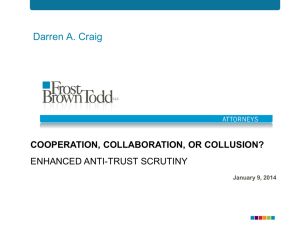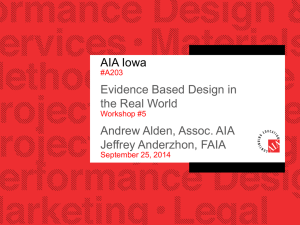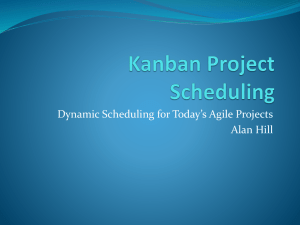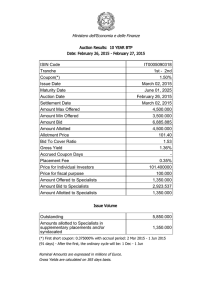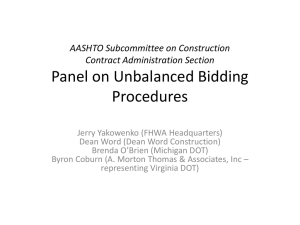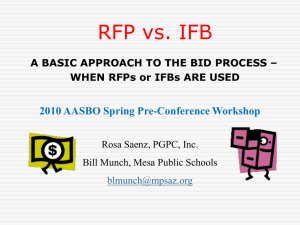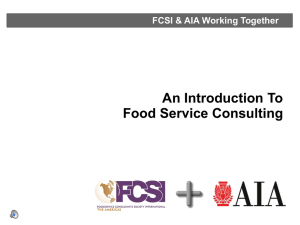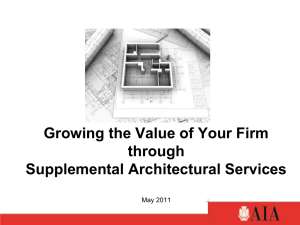Building Success Stories: A Survey of Construction Delivery Methods
advertisement
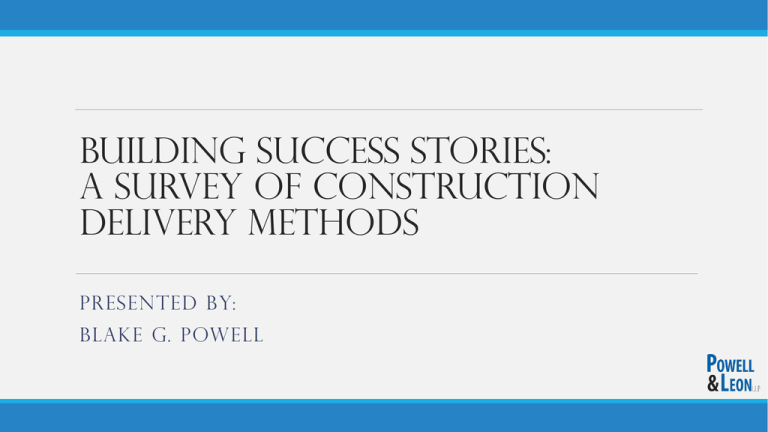
Building Success Stories: A Survey of Construction Delivery Methods PRESENTED BY: BLAKE G. POWELL Texas Government Code § 2269.001 et seq. Construction Delivery Methods Competitive Bidding Competitive Sealed Proposals Construction Manager-Agent Construction Manager –At-Risk Design-Build Job Order Contracts Competitive Bidding (“Hard Bid”) TEX. GOV’T CODE § 2269.101 ET SEQ. Construction, alteration, rehab/repair of a facility Gov’t shall select A/E to prepare construction documents (“CDs”) Request for bids must include: (CDs, estimated budget, scope and estimated project completion date) Advertise for bids Publicly open and read aloud “names of the offerors and their bids” Select (award to) lowest responsible bidder Not later than 7th day following award, document basis and make evaluations public Competitive Sealed Proposal (“CSP”) TEX. GOV’T CODE § 2269.151 ET SEQ. Gov’t requests proposals, ranks offers, negotiates then contracts for construction, alteration, rehab/repair of a facility Gov’t shall select A/E to prepare CDs Request for CSP must include: (CDs, selection criteria/weighted values, estimated budget, scope and estimated project completion date) Publicly open and read aloud names of the offerors and their monetary proposals Not later than 45th day following award, document basis and make evaluations public Select (award to) proposer that submits “best value” based upon criteria values and ranking Construction Manager-Agent(“CMA”) TEX. GOV’T CODE § 2269.201 ET SEQ. Description: Standard method of construction contracting with award to the lowest responsible proposers for each scope of work. Multiple prime contracts are awarded. The CMa acts on behalf of the District in a fiduciary capacity for a fixed fee. Prime Players: District, Architect/Engineer, Construction Manager Agent and General Contractor or Multiple Prime Contractors. Construction Manager-Agent(“CMA”) TEX. GOV’T CODE § 2269.201 ET SEQ. • Best Suited: Complex projects, schedule sensitive projects, or projects subject to change • Least Suited: Utility projects Advantages: • Faster Delivery Schedule • Helps Build Integrated Team • Design Phase Builder Assistance • Fixed Fee by the CMa so the District’s best interest is always first • Most Transparent Bid Process (Bids are opened and read aloud at a deeper level than normal) • Check and Balance between A/E and Contractor Disadvantages: • Multiple Prime Contracts • Prime Contractors (Typically Subcontractors) are required to have bonding and insurance as required by law alleviating some firms from participating Construction Manager-at-Risk(“CMAR”) TEX. GOV’T CODE § 2269.251 ET SEQ. Description: Construction Manager is brought on earlier in the design process to allow for interface with design consultants. Selection can take into account factors in addition to price, including vendor reputation, quality of goods or services and vendor’s past relationship with the District. Prime Players: District, Architect/Engineer, Construction Manager At Risk. Enables fast-track delivery (beginning construction before design is complete) Design-Contract-Build Construction Manager-at-Risk(“CMAR”) Best Suited: Larger projects that are complex , schedule sensitive, difficult to define, and/or change subject to change Least Suited: Smaller projects Advantages: • Faster delivery schedule • Helps build integrated project team • Design phase builder assistance/ expertise • Early construction cost commitment • Change flexibility • Single point of responsibility for construction • Check and balance between A/E and contractor Disadvantages: • Scope is not clearly defined if selection occurs during design process • Percentage based fees promotes higher budgets • Hidden costs in GMP for cost of work items • Subcontractor bids are not always “best value” • Contractor controls Contingencies Design-Build(“D-B”) TEX. GOV’T CODE § 2269.301 ET SEQ. Gov’t contracts with a single entity to provide design and construction services for construction, alteration, rehab/repair of a facility D-B firm must include and A/E Gov’t must also select an A/E independent of D-B firm for project D-B firm selected from RFQ criteria / best value / ranking process Job Order Contracts(“JOCs”) TEX. GOV’T CODE § 2269.401 ET SEQ. Allowed for: “maintenance, repair, alteration, renovation, remediation, or minor construction of a facility when the work is of a recurring nature but the delivery times, types, and quantity of work required are indefinite” Whether to use A/E depends on nature of the work Gov’t may procure through CSP or Interlocal Contract Gov’t may award to multiple contractors Term may not exceed 2 years Fixed or unit pricing allowed Decision Making Factors Time ◦ Start with the “end” in mind (maze mentality) ◦ When will you move in? ◦ “Back Into” your time schedule Money ◦ What is the cost difference? External Stakeholders ◦ What do they expect? Control ◦ What level of control do I want to exercise? Delivery Schedule Figure 1 – Traditional Bid Process Total Delivery Time – In Months Design Bid Build Figure 2 – Design Build/CM-at-Risk Total Delivery Time – In Months Design Bid Build Decision Matrix Contract Forms Delivery Method Contractor Form Architect Form AIA – A101 & AIA – A201 AIA – B141 CM Agency AIA – B801CMa (CM) AIA – B141CMa CM-at-Risk AIA – A121 – CMc/AGC Form 565 AIA – A201 AIA – B141 Design Build AIA – A191 (part 1 & 2) N/A Traditional Bid/Sealed Proposal Purchasing Requirements for Subcontractors • Competitive Sealed Proposals • Public opening by owner • Must define selection criteria and weights • CM – Agency • Hard bid • Public opening • Competitive sealed proposals • Multiple contracts • CM-at-Risk • Bids or proposals • Opened privately • Public only after ward • Difficult for owner to evaluate without good scopes of work • Design/Build • No requirements for subcontractor bids Construction Cost Pyramid Estimated Cost Start of Project CM/Contractor Owner GMP or Hard Bid $ Summary of Subcontractor Pricing, General Conditions, Soft Costs, CM Fees, and Contingency Actual Cost End of Project Cost of Materials, Labor, Insurance, Bonding, Job Site Costs, and Change Orders Timing the GMP Consider the Split of Contingency Narrow down the “Guesswork” Inverse relationship between plan completion and contingency Defining Contingency Clearly define the components of “Cost of the Work” ◦ Closely related to timing of GMP ◦ Mostly used for items included in the plans, but not picked up by ◦ bidding process Review all contract amendments carefully Set rational expectations Insist on monthly usage reports Managing Disagreements Delete Arbitration Consider adding Non-Binding Mediation Keep all transactions at “arm’s length” and within the contract documents Consider monthly meetings with all Parties Consider Partnering Avoiding Pitfalls • Choose delivery method and do it in a board meeting • Follow the purchasing statutes • Use the right contract for the method you have chosen • Understand the components of construction cost • Time your GMP properly • Clearly define contingency • Manage disagreements effectively Blake G. Powell Powell & Leon, LLP 115 Wild Basin Road, Suite 106 Austin, Texas 78746 Phone: (512)494-1177 Facsimile: (512)494-1188 Email: bpowell@Powell-leon.com www.Powell-leon.com


